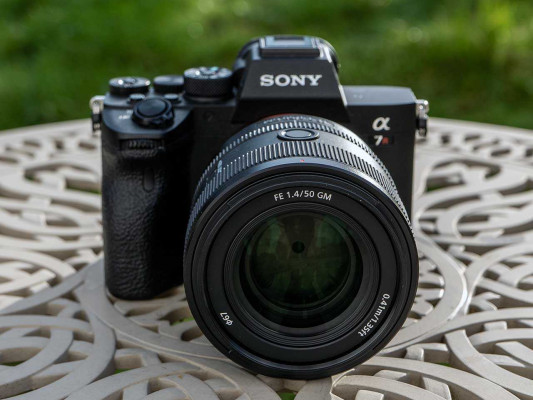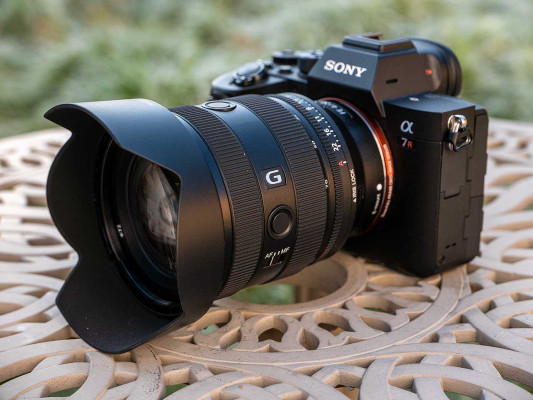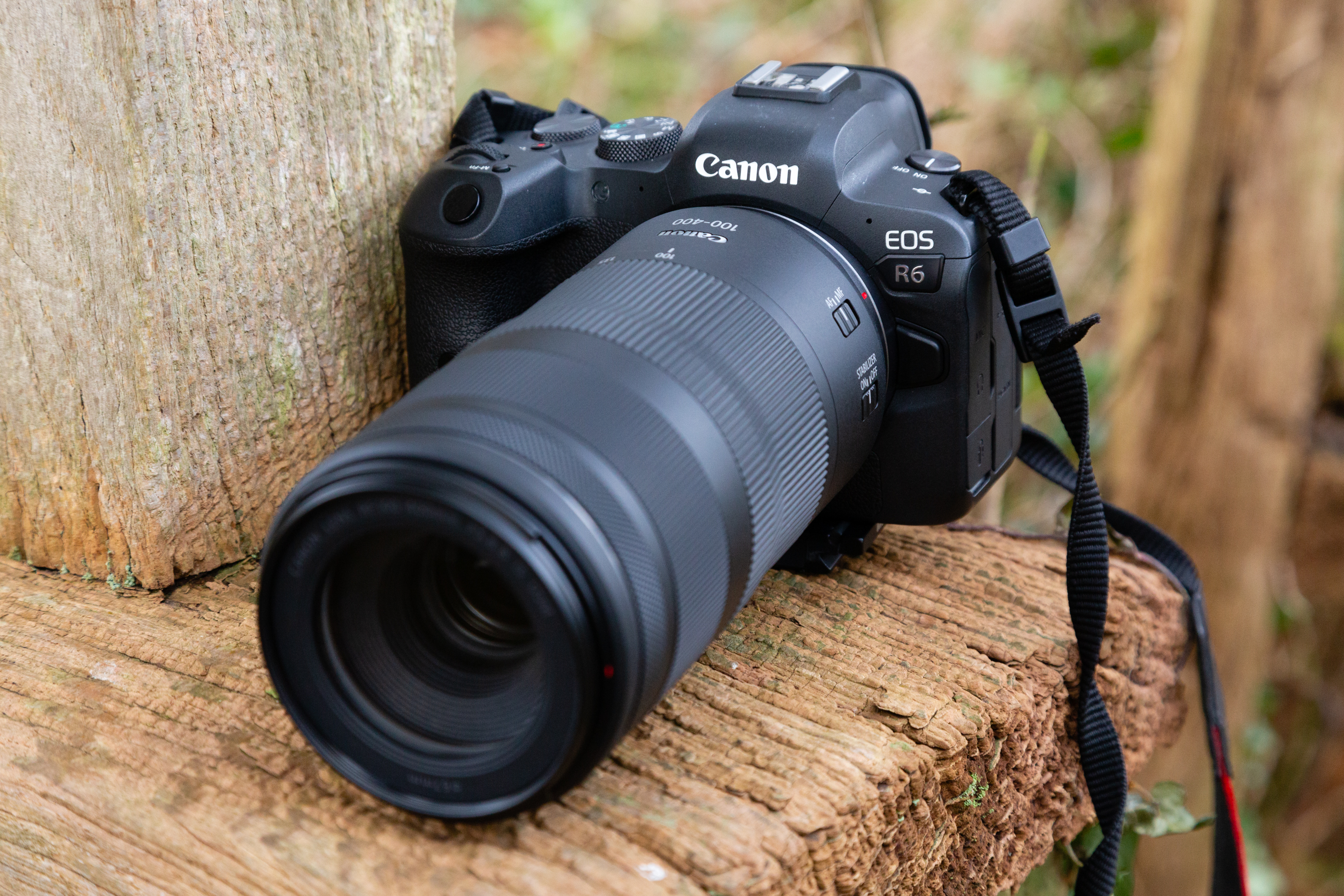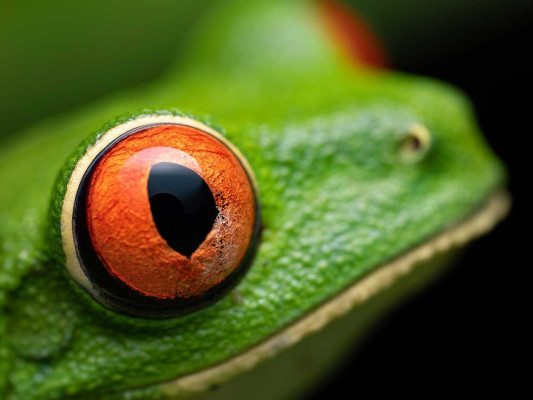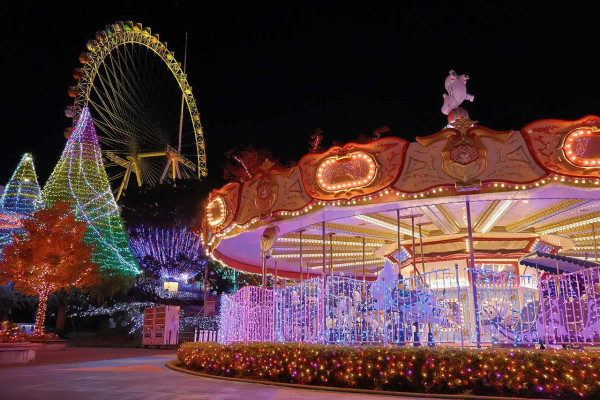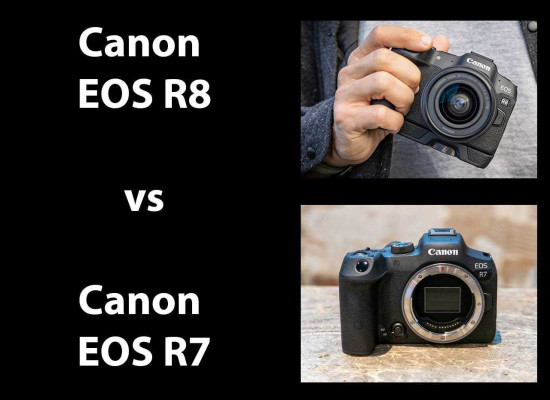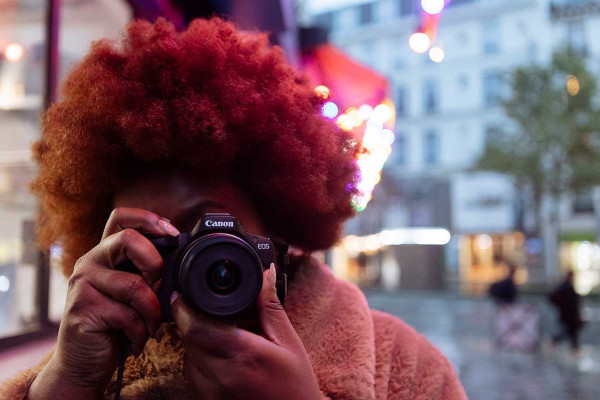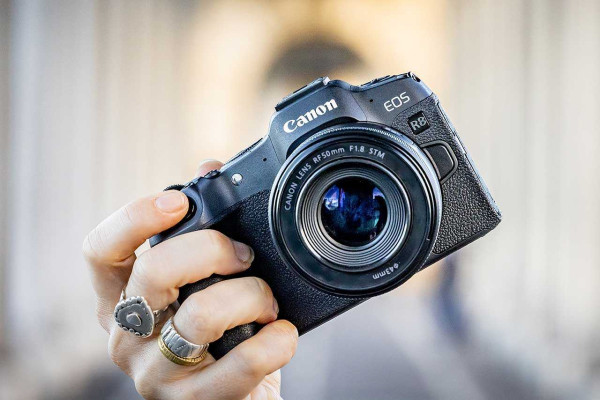Reviews

Canon EOS R6 II review
DPReview Latest |
Product images by Dale Baskin
The Canon EOS R6 II is a 24MP full-frame camera aimed at enthusiast photographers and video shooters. It may look identical to its predecessor on the outside, but it gains useful new features for stills and video while providing a refined shooting experience.
Key specifications
- 24.2MP CMOS sensor
- 12fps mechanical shutter (40fps electronic shutter)
- Built-in image stabilization rated to 8.0 stops
- People, animal, and vehicle AF subject detection
- 4K/60p video (oversampled from 6K)
- 6K ProRes RAW video with a compatible Atomos recorder
- Raw burst mode with pre-capture
- Moving subject HDR mode
- 3.68M-dot EVF capable of up to 120 fps refresh (0.76x magnification)
- 1.62M-dot, 3-inch rear touchscreen
- Dual UHS-II SD card slots
- 580 shot-per-charge battery rating (CIPA)
The EOS R6 II is available for a retail price of $2499. A kit with the Canon RF 24-105mm F4-7.1 IS STM USM lens is available for $2799, and a kit with the Canon RF 24-105mm F4 L IS USM lens is available for $3599.
Jump to:
What's new | How it compares | Body & handling | Initial impressions | Image quality | Video | Conclusion | Sample gallery | Specifications
What's new
24MP full-frame sensor
 |
The headline new feature of the R6 II is a new 24.2MP full-frame sensor, up from 20MP in the original R6. That's not a massive increase in effective resolution, but it does allow the R6 II to match the resolution of many popular enthusiast cameras.
As is typical for EOS bodies, the new sensor is designed and manufactured by Canon. However, despite being the same size and resolution as the sensor in Canon's current flagship, the R3, it's neither a BSI nor a stacked sensor. Despite this, Canon says rolling shutter performance is still improved relative to the sensor in the R6. It's capable of burst rates up to 40fps with the electronic shutter, though the camera drops to 12-bit readout to achieve this.
Video features
The original R6 could capture UHD 4K/60p video but with a couple of limitations: it forced a slight crop (1.07x) from the full width of the sensor, and video in all modes was capped at 30 minutes per clip. The new model improves in both areas while adding some exciting new features.
The R6 II captures oversampled UHD 4K/60p video using the entire width of its sensor – no more crop. It's also possible to capture 4K/60p from an APS-C crop of the sensor. In both cases, thermal performance appears to be improved. Canon claims you can record 4K/60p for up to 40 minutes using the full sensor width, and up to 50 minutes in APS-C mode, assuming an ambient temperature of 23°C (73°F). There are no time restrictions when shooting at slower frame rates like 4K/30p or 4K/24p.
High frame rate performance has also been improved, with the R6 II able to capture up to 1080/180p, compared to 1080/120p on the R6. However, Full HD footage is not oversampled, so there's some loss in quality. Canon says you should be able to record for 60 minutes or longer in this mode before overheating becomes an issue. That's a lot of slow-motion footage.
Our team at DPReview TV were able to record 4K/60p for over an hour at room temperature (presumably below 23°C), which suggests overheating isn't a particularly significant issue on this camera unless you need to record long clips, such as interviews, at 4K/60p.
 |
The R6 II also supports a ProRes RAW video workflow when paired with a compatible Atomos recorder. This includes 6K Raw video using the entire sensor width or 3.7K Raw video using a Super35 crop. The camera can simultaneously record FHD proxy files internally when using the external Raw workflow. Support from Atomos wasn't available to test on our pre-production body, but support is typically announced alongside a new camera launch.
In other nods to video users, Canon added several features to improve the video workflow. When working in video mode, the Q menu presents a different interface that's more video-oriented and, as in stills mode, the Q menu can be customized.
The camera also includes a variety of aspect ratio markers, both horizontal and vertical, and a false color display that makes it easy to judge the exposure of a scene. It also has a mode you can activate to automatically pre-record and buffer video for three or five seconds, saving the clip from before you hit the record button.
Autofocus
 |
According to Canon, the R6 II incorporates more machine learning in its AF algorithms and inherits some of the technology from its flagship EOS R3 (but not the R3's eye-controlled AF system). The result should be improved stickiness as the camera tracks subjects.
The R6 II adds new subject tracking modes, going beyond the 'people' and 'animal' options found on the R6. There's now a 'vehicle' option optimized for motorsports, cars, motorcycles, aircraft (including helicopters) and trains. Animal tracking now includes support for horses (and zebras, for those going on safari), with the camera set to recognize both the eye and the head.
When photographing people, the camera can now be set to focus on either the left or right eye or to select the closest eye automatically. For more control, it's possible to set a custom button to toggle back and forth between either eye manually.
However, the addition that may prove most useful is a new 'auto' mode for subject recognition and tracking. Instead of pre-selecting your subject mode, auto combines all the subject-specific modes and attempts to apply the best algorithm based on the detected subject. This can significantly simplify the shooting workflow when photographing mixed subjects.
Finally, when shooting video, the R6 II includes a new 'detect only' AF mode. When tracking a subject that disappears out of frame, this mode instructs the camera to leave focus where the subject left off rather than hunting back and forth for new subjects.
Raw burst mode
 |
Raw burst mode is a new feature that layers some potentially helpful features on top of the camera's 40fps shooting capability. It works only with the electronic shutter.
When shooting a burst of Raw images, the camera groups the entire set of photos together and presents itself in playback mode under a single thumbnail image with a special icon. You can then browse the series of images from a single burst, similar to how you browse a group of burst images on many smartphones, and select the best shot(s) from each sequence to save.
This feature has the potential to be quite helpful. In most scenarios where burst shooting is common, chances are pretty good that what you're really trying to do is nail a single decisive moment, such as a diver at the instant before they enter the water. Raw burst mode allows you to review each burst sequence and save the one or two shots you care about.
Raw burst mode also includes an optional pre-shooting feature. When enabled, a half-press of the shutter button tells the camera to begin buffering frames. Once the shutter is fully depressed, the camera will capture a half second of buffered pre-click images, followed by the rest of the shots in the burst.
Moving subject HDR
Canon has added a new feature it calls moving subject HDR. Canon claims this mode can capture additional dynamic range with virtually no ghosting of moving subjects, though it has some limitations. To start, it won't output Raw files, so you'll be limited to JPEG. In our pre-production body, it also slowed down burst shooting somewhat. Finally, moving subject HDR raises the base ISO to 800. In our limited use, it produced images that looked over-processed, and we didn't particularly like the exaggerated results, but we haven't tested it on a full production body.
The camera can also create HDR PQ stills, realistic-looking single images suitable for playback on an HDR TV.
Odds and ends
The R6 II includes a high-frequency flicker mode similar to the one found in the R3. It's designed to let you fine-tune the shutter speed to compensate for things like digital scoreboards and LED lighting that operate at high frequencies.
How it compares
The EOS R6 II slots into one of the most competitive segments of the full-frame camera market: mid-level models aimed at enthusiasts or even pros.
The bump from 20 to 24MP may not be a colossal increase in effective resolution, but it's probably a smart move in a market where 24MP has become the de-facto standard, and some models are starting to creep upward from there (we're looking at you, a7 IV).
The R6 II seems to hit its sweet spot in this group at the performance end of the spectrum. Canon's well-regarded AF system and 40fps electronic shutter give it a leg up. It's also strong on the video front, delivering oversampled 4K/60p from the full width of its sensor and support for a 6K Raw (external) workflow.
| Canon EOS R6 II | Sony a7 IV | Nikon Z6 II | Canon EOS R6 | |
|---|---|---|---|---|
| MSRP at launch | $2500 | $2500 | $2000 | $2500 |
| Sensor size/type | FSI CMOS (Dual Pixel) | BSI CMOS | BSI CMOS | FSI CMOS (Dual Pixel) |
| Pixel count | 24MP | 33MP | 24MP | 20MP |
| Max burst speed | 12fps mech shutter 40fps electronic (12-bit) |
10fps (lossy Raw) | 14fps* | 12fps mech shutter 20fps electronic |
| Image stabilization rating (CIPA) | Up to 8EV | Up to 5.5EV | Up to 5.0EV | Up to 8EV |
| Flash sync speed | 1/250** | 1/250 | 1/200 | 1/250** |
| Low light AF rating*** | –5.0EV | –4.0EV | –4.5EV (–6EV low light AF mode) |
–5.0EV |
| EVF res / mag | 3.68M dots / 0.76x |
3.69M dots /0.78x |
3.68M dots / 0.80x |
3.68M dots / 0.76x |
| Rear screen | 1.62M-dot fully articulated touchscreen | 1.04M fully-articulated touchscreen | 2.1M-dot tilting touchscreen | 1.62M-dot fully articulated touchscreen |
| Video max res/rate | UHD 4K/60p (full width, from 6K) |
UHD 4K 30p (full width) UHD 4K 60p (1.5x Crop) |
UHD 4K 30p (full width) UHD 4K 60p (1.5x Crop) |
UHD 4K 60p (1.05x crop) |
| Battery life LCD / EVF (CIPA) | 580 / 320 | 580 / 520 | 410 / 340 | 510 / 380 |
| Card formats | Dual UHS-II SD | 1x CFe Type A / UHS-II SD 1x UHS-II SD |
1x CFe Type B 1x UHS-II SD |
Dual UHS-II SD |
| Weight | 670g (23.6oz) | 659g (23.2oz) | 705g (24.9oz) | 680g (24.0oz) |
Body and handling
Body and controls
 |
The EOS R6 II should feel familiar to anyone using EOS bodies. It has three main dials, one for your index finger next to the shutter button, one for your thumb on the back of the top plate, and a large dial on the rear plate, a control that goes back to Canon's pre-digital days. The dials can all be customized to provide the operational workflow that suits you best.
The body and control layout of the R6 II is almost identical to its predecessor. It has the same grip, the same curves, the same buttons (mostly), the same dimensions, and even works with the same vertical battery grip as the R6. Like the R6, it feels substantial in your hands, and Canon describes it as dust and weather-resistant, though not to the degree of more expensive models like the R3 or R5.
In fact, there are only a couple of notable physical differences between the R6 and R6 II, but they're important ones.
The most obvious change is that the on/off switch, previously located on the camera's left shoulder, has been relocated to the right shoulder. In its place, the left shoulder is now the home to a dedicated stills/video switch that looks and feels almost identical to the old power switch.
 |
For existing R6 users, there's some potential for confusion here, and you may initially find yourself toggling between stills and video instead of turning the camera on or off. Once you get used to it, however, the new location for the power button makes a lot of sense, as it allows you to pick up the camera and turn it on with just one hand. Having a dedicated switch to toggle between stills and video is also handy. However, the switch on our pre-production unit wasn't quite stiff enough to prevent it from inadvertently getting moved a few times by accident.
The camera's rear is unchanged, with one minor exception: the joystick on the R6 is slightly concave, whereas the joystick on the R6 II is somewhat convex. This seems like a modest change, but the concave shape of the R6's joystick made it easy to differentiate by feel from surrounding buttons. In contrast, the convex shape of the R6 II's joystick makes it more challenging to identify. On the whole, we prefer the concave design.
The R6 II also shares one feature with the R6 that's historically reserved for Canon's more pro-oriented bodies: the 'Rate' button on the top left shoulder. It can apply star ratings in the field while reviewing images in playback mode, which are readable by most photo editing software.
Displays and connections
 |
The R6 II has the same 1.62M-dot, 3" rear touchscreen as its predecessor, along with the same 3.68M-dot electronic viewfinder that can run at either 60 or 120 fps, with 0.76x magnification.
One minor functional improvement comes from Canon's OVF simulation mode, which debuted on the EOS R3 and provides a more SLR-like display experience. On the R6 II, this feature doesn't benefit from the higher dynamic range display found on the R3, so it's a bit less compelling.
The R6 II does receive an upgrade in the form of Canon's multi-function accessory shoe, which provides support for advanced strobes, microphones, or a Tascam audio adapter that accepts XLR microphone connections and facilitates 4-channel audio.
The camera uses dual UHS-II SD card slots, opting not to include a CFexpress slot like we've seen on some recent models. It also includes a USB-C port, mic and headphone jacks, and a plug for a wired remote. There's an HDMI-out port, but it uses the ever-so-fragile micro-HDMI connector, something that's sure to make a few video shooters cringe, especially if they plan to use an off-camera recorder.
The menus on the R6 II will be familiar to anyone who has used a Canon camera. However, Canon says it has simplified the process of making Bluetooth and Wi-Fi connections, something we didn't get to try on our pre-production unit. The camera also supports MFi connectivity, meaning you can plug it directly into an iPhone to transfer files.
Battery
 |
The R6 II uses the same LP-E6NH battery found on many other EOS cameras, although Canon has improved battery life. It gives the R6 II a CIPA-rated 580 shots in its default (smooth) mode when using the rear LCD or 320 shots per charge through the viewfinder. This compares to CIPA ratings of 360 and 210 on the original R6. All these numbers increase to 760 and 450, respectively if you engage power-saving mode.
CIPA ratings provide a helpful basis for comparing battery performance between cameras but often underestimate battery life compared to many people's real-world usage. True to form, we far exceeded these numbers on our pre-production body when used with either the EVF or rear LCD but the rating of 320 shots per charge for EVF use is rather low for this class of camera.
Initial impressions
By Dale Baskin
 |
The EOS R6 II is, predictably, a refined version of the original EOS R6. Where the R6 was a solid camera, the R6 II gives a sense of being a more well-rounded product with the potential to appeal to a broader range of users.
In one sense, the R6 II may be Canon's best current example of a Swiss Army Knife type of camera: it doesn't excel at any one thing to the point of becoming a specialty or niche product, but it has the potential to do an awful lot of things exceptionally well. It certainly benefits from the fact that Canon now has several years of mirrorless EOS development under its belt, paving the way for a more advanced mid-level camera.
After shooting thousands of frames on a pre-production R6 II over a couple of days, I came away with the sense that it can be a pretty fast camera. Fast is relative: the R6 II doesn't have a stacked sensor like the R3 (and at this price point, I wouldn't expect it to), but if you need to shoot quickly, 40fps will get you there, and I was pleasantly surprised at how infrequently rolling shutter artifacts showed up in images from fast-moving sports.
Of course, that 40fps works partly because the R6 II benefits from Canon's excellent mirrorless AF system, which has now had a few years to mature. Even on a pre-production body, I found it surprisingly responsive, often taking only a split second to lock onto a fast-moving target like a BMX bike flying into the frame from the side. The fact that the AF system now has a recognition mode to detect different types of subjects makes this an even smoother experience.
 |
Many of the improvements to this camera come from improved workflows for stills or video. For example, the Raw burst mode has the potential to be a real time saver. The ability to step through each burst, smartphone-style, and pick one or two keepers from each sequence while planted in an airplane seat is appealing. Similarly, the ability to pre-buffer photos before pressing the shutter button, as other camera systems can do, can be a huge help when things are about to move quickly.
Canon seems intent on improving video workflows as well. In addition to improved video specs and better thermal management, tools like a video-centric Q menu, false color display, and the ability to pre-buffer video for up to five seconds should appeal to videographers. This also adds to the mystery of why Canon hasn't addressed one of the more common complaints from video shooters: the inability to use the histogram or level gauge once recording starts.
The EOS R6 II is a very capable camera that ticks a lot of boxes. The original R6 was a solid camera, too; in fact, we recommended it in our buying guide as the best camera for around $2000 for a long time, so the fact that the R6 II improves in some critical areas while adding useful new tools is a very good sign. I look forward to getting my hands on a full production model and pushing it further, shooting a more diverse range of subjects and finding out just how much it can do.
Image quality
Studio Scene
Our test scene is designed to simulate a variety of textures, colors and detail types you'll encounter in the real world. It also has two illumination modes to see the effect of different lighting conditions.
The move from 20MP in the EOS R6 to 24MP in the Mark II doesn't make a huge difference in terms of detail capture but brings the quoted spec into line with most of the camera's immediate peers. In terms of noise, the EOS R6 II delivers a very similar performance to its rivals at moderate ISOs. Both the R6 II and the Sony a7 IV fall a fraction behind at their very highest ISO settings.
Its JPEG sharpening does a good job of pulling the fine detail out of the Raw data, though its noise reduction at higher ISOs isn't as good at retaining detail as the best of its contemporaries. This difference becomes more apparent in more challenging lighting.
The JPEG color response is the usual attractive Canon output, with fairly saturated blues and greens, rich caucasian skintones and yellows that lean slightly towards the orange, rather than green. This translates to very likeable photos in most situations.
Noise reduction
In terms of dynamic range the EOS R6 II performs comparably to its immediate full-frame peers. However, if you look at the very deep shadows (that might become visible if you're trying to exploit the camera's full DR), there appears to be some slight smudging of detail. This looks like the noise reduction Canon was applying in the EOS R5. It's not necessarily a big deal, since these very darkest tones are near unusably noisy anyway, but it is a factor in how the R6 II can appear to perform so well.
Here are our ISO 6400 and ISO 200 + 5EV images from the ISO Invariance test, reprocessed with noise reduction minimized:


High speed shooting
We checked both the rolling shutter rate and the impact on dynamic range of engaging the camera's high speed e-shutter modes. In terms of rolling shutter, we measured it as 18ms (1/56 sec). This isn't especially fast when compared to the likes of the Sony a9 (1/150 sec), but it's quick enough that even fairly fast-moving subjects shouldn't be too heavily distorted if they move across the frame as you take a photo. We wouldn't recommend using the EOS R6 II's 40fps mode for close-up motorsports or golf-swing analysis, though.
Exposure latitude test | ISO invariance test
To achieve this speed, the sensor appears to drop to 12-bit readout mode (which most cameras do, to deliver usably fast electronic shutter readout). This results in the camera not having enough precision to fully encode its entire dynamic range, which is likely to be a major part of why the deep shadows of its Raw files become significantly more noisy.
Video handling
 |
| The EOS R6 II does a lot more than just providing a switch, in terms of making stills/video switching simple. |
The EOS R6 II is a well-specified video camera which separates its stills and video settings so that you don't accidentally find yourself using movie-appropriate shutter speeds and white balance settings if you quickly jump from video mode back to stills.
The support tools include a false color display (with a simple key in the menus), which helps with exposure settings; it continues to work in both C-Log and HDR PQ modes, but can't be used in conjunction with C-Log's 'View Assist' corrected preview. It also can't be used in conjunction with zebras or focus peaking, as you might expect. False color does remains active while recording, unlike the on-screen histogram or levels gauge.
Interestingly, you can modify the options and their positions in the Q menu for both stills and video modes but, while you can add zebras or peaking to the Q menu, you can't add access to the false color mode or to the camera's pre-record video mode.
These tools make it easier to shoot images that are well-exposed and focused. Other options that can be added to the Q menu include Movie Servo AF speed and tracking sensitivity. However, we've found the AF to be significantly less dependable than in stills mode, regularly jumping to the background.
The R6 II can output a data stream for encoding as ProRes RAW if you connect an Atomos recorder, but the camera's micro HDMI socket risks making this unreliable in the long term. It's also worth considering how much of a benefit you find this way of working gives over a 10-bit C-Log3 approach.
Video performance
We have tested the rolling shutter rate of the R6 II's various video modes and shot video stills for its full-width and cropped 4K output, to assess detail capture levels.
When using its full sensor width, the R6 II's output looks a lot like that of its immediate peers. Where it impresses is that its 60p capture looks the same as its 24p footage. By contrast, both the Sony a7 IV and Panasonic DC-S5 have to crop in to deliver 60p.
The EOS R6 II's crop modes are a little less detailed than the full-width ones (and we'd expect a noise cost to cropping, too). They still compare favorably to the crop modes of its rivals, despite seemingly capturing a region slightly less than 3840 x 2160 pixels and upscaling the result.
In terms of rolling shutter, the EOS R6 II does very well, posting comfortably sub-20ms numbers for its oversampled full-width capture and circa-10ms numbers from its 1.6x cropped region.
| 60p | 23.98p | |
|---|---|---|
| Full-width | 15.2ms | 16.9ms |
| 1.6x crop region | 9.5ms | 10.5ms |
For reference, the 24MP sensor used in the Panasonic S5, Nikon Z6 II and Sony a7 III takes around 22ms to read out its full-width 4K, with some rolling shutter effect as the consequence. The a7 IV's full-width 24p capture takes around 27ms and the original EOS R6's around 30ms, making both very prone to visible rolling shutter distortion.
That said, we found there's enough rolling shutter that it seems to exaggerate the action of the camera's image stabilization. Particularly when using wide-angle lenses, the R6 II's IBIS can tend to exhibit some strange warping wobble at the corners of the frame.
Autofocus
The EOS R6 II has the latest version of Canon's AF interface: you can choose from up to five AF area sizes from 'spot' to 'whole area.' There are also three customizable area modes, which let you define rectangles of different sizes and proportion to suit the movement of your subject within the frame. In continuous AF mode ('Servo AF' in Canon's terminology) you can engage tracking, which will then try to follow whatever was under or near your chosen AF region.
I say 'near' because the camera will try to choose a subject to track, and that subject may be something immediately next to your AF point, rather than the object you intend. This can be useful if you're hoping the camera will track one of the subjects it's been trained to recognize, but can occasionally be frustrating when you aim it at a specific detail and find that it's drifted off to something nearby that it found more interesting or distinctive. This habit of picking the wrong subject was primarily an issue when trying to use AF tracking to stay locked onto a specific point while recomposing the shot, rather than when tracking moving subjects.
Particularly with 'people' detection turned on, the camera was extremely good at continuing to track a chosen subject, though, even when they looked away and despite the potential confusion of other people in the scene. Overall, the Canon's AF system succeeds in being both simple and powerful.
As we mentioned, video AF is a little less dependable, though it's worth nothing that, when in movie move, the 'Movie Servo AF' option provides you with a choice about whether the AF system should prioritize recognized subject types or solely focus on recognized subjects. We found that setting 'Subj. detect AF' to 'Detect. only' significantly improved video AF's reliability when focusing on people.
Conclusion
By Richard Butler
| What we like... | What we don't... |
|---|---|
|
|
Like all its rivals, the EOS R6 II delivers excellent image quality and, like the best of its peers, it back this up with simple, decisive autofocus and can shoot very good video. In an of itself, this combination makes it very attractive: its autofocus is better than that of the Nikon Z6 II and its video has the edge over that of the Sony a7 IV.
The feature that really sets it apart from its contemporaries is its ability to shoot at up to 40fps and to pre-buffer bursts, to help you capture the key moment. Its rolling shutter means these modes aren’t ideal for capturing very fast movement, but it’s good enough to be genuinely useful. It doesn’t suddenly make it a mini EOS R3, but it further expands the types of photography the R6 II can accommodate.
Quite apart from the specs and capabilities, the EOS R6 II is simply a very nice camera to use. Its menus are long, but its grip is comfortable, its controls well placed, and a great deal of consideration has clearly been given to how many control points it needs. It feels like a well-honed tool, refined by people who’ve spent a lot of time using cameras.
This isn’t the whole story though. The RF mount is relatively young and still lacks a lot of the mid-priced lenses an enthusiast might want to fit on a body like this. Canon’s older ‘EF’ lenses can be used, if you have them, but mounting a DSLR lens on the end of an adapter isn’t the same as having modern, native lenses available. Battery life (especially when using the EVF) also feels a little limiting for a camera as otherwise capable as the R6 II.
Overall, though, it’s a camera that impresses every time you use it and, up against some of the best cameras you can buy, that counts for a lot.
Canon EOS R6 Mark II Category: Semi-professional Full Frame Camera |
Build quality Ergonomics & handling Features Metering & focus accuracy Image quality (raw) Image quality (jpeg) Low light / high ISO performance Viewfinder / screen rating Optics Performance Movie / video mode Connectivity Value | PoorExcellent | ||||
Conclusion The Canon EOS R6 II stands out even from the very capable crowd of $2000-2500 full-frame cameras. It offers comparable image quality to its peers, competitive autofocus, very good video and the fastest burst shooting in its class. Like a swiss army knife, it's remarkably useful for a range of different things. | |||||
| |||||
| |||||
Sample gallery
Please do not reproduce any of these images on a website or any newsletter/magazine without prior permission (see our copyright page). We make the originals available for private users to download to their own machines for personal examination or printing (in conjunction with this review); we do so in good faith, so please don't abuse it.
Pre-production sample gallery
All images shot using a pre-production Canon EOS R6 II.





